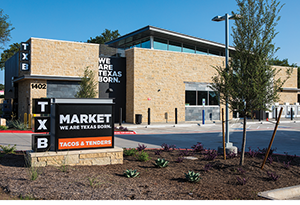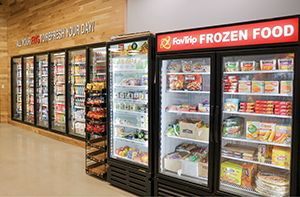The first step in real-estate development is knowing how the local building and construction process works in order to set expectations at the outset for what could be a relatively smooth—or bumpy—journey.
In some cases, Kevin Smartt, CEO of TXB Stores, knows upfront it will be a three-year time frame. “We see variances in the skillset of cities, or in how much they really want a convenience store or other specific businesses in the area,” he said. “Some are more challenging than others. Identifying that is important, especially if you are trying to drop in multiple stores in a certain time frame.”
Smartt’s preference, whenever possible, is to request approval for both the building site and the building plan simultaneously. “If we can get those both approved at the same time, it goes a lot quicker and tends to be smoother.” That said, surprises do arise.
At the end of the construction cycle for every new store built, the project team gathers to discuss what they may want to tweak as it looks to the next new build.
During the process of opening a new store in one suburban location, TXB created a custom steel structure that Smartt described as a piece of art. “We had an ironsmith design and build it. It was 8-feet tall and said ‘welcome.’ We thought it was a nice addition and something any town would be proud to have,” he said. Unfortunately, the city deemed it a building sign, meaning it was subject to that set of restrictions, even though the sign did not advertise the store. The city’s decision meant another three months added to the opening date to go through an extra permit application process. In the end TXB opted to take down the sign to avoid holding up the store opening. “Little battles come up all the time when trying to do creative things outside the box,” Smartt said.
In addition to making necessary adjustments per city regulations and working through those elements, often retailers also incorporate their own changes and improvements as they continue to build new stores. For Smartt, there is always room for improvement with every new store. TXB established an ongoing review process with that in mind. At the end of the construction cycle for every new build, the project team discusses what it may want to tweak as it looks to the next build. “We go back through the store with our architect, operations team and project management team to pinpoint what still needs to be tweaked,” Smartt said. “We continually try and make the prototype better.”
 It can prove a frustrating process, Smartt admitted. “When we are building out new stores, I keep the frame of mind that no design is going to be perfect,” he said. “Even for us, building multiple stores, it’s not perfect.”
It can prove a frustrating process, Smartt admitted. “When we are building out new stores, I keep the frame of mind that no design is going to be perfect,” he said. “Even for us, building multiple stores, it’s not perfect.”
ESCAPING LIMBO LAND
Babir Sultan, president of FavTrip, was in opening-day limbo for months. He had planned to open the doors of the first ground-up FavTrip store in December, but the location had a few setbacks that are likely relatable to anyone who’s opened a new store.
“It’s been interesting,” Sultan said of the permitting, zoning and overall approval process. After finally receiving the letter of occupancy at the end of January, which he thought was the final phase, he learned he needed another formal approval to sell gasoline. “We are planning a soft opening to work out the kinks and then a grand opening sometime in February,” he said. The new c-store opened February 16.
When opening day arrived, this FavTrip store in Grandview, Missouri, marked a full-circle journey for Sultan, who recalls working as a c-store cashier in the city 16 years ago. “It has been on my bucket list to build a store,” he said. “This checks that off.”
FavTrip’s store count is three. His advice to other small chain owners is to study location data. “A lot of people say location data is only available to the big brands,” he said. “Even though we are small, we found a way.”
Little battles come up all the time when trying to do creative things outside the box.”
GETTING CREATIVE
Sultan’s entrepreneurial spirit and ability to network with industry peers paved the way to a solution. While larger brands might have their own in-house team to navigate site selection, Sultan found a different resource. A program at the University of Iowa gives students a business problem to solve each semester, so Sultan nominated his challenge of finding a spot. “The Kansas City area is saturated, and a lot of the bigger brands already have the best lots. You have to really depend on data if it’s not going to be a corner lot,” he said.
The 26 Iowa students were divided into eight groups; each group tackled a different issue related to picking a site and presented their findings. Traffic count and sales potential were among the factors that the students investigated. In the end, Babir chose one of the site recommendations. From there, he credits Paragon Solutions with designing what he deems FavTrip’s flagship store.
I think it’s always going to be a little bit of a leap of faith.”
The new development totals 9,000 square feet: The FavTrip store totals 4,000 square feet, with the remainder of the facility built out for two tenant spaces. The c-store space is more than double the 1,500-square-feet average of the other FavTrip stores. The extra square footage accommodates a foodservice program.
“I think it’s always going to be a little bit of a leap of faith,” Babir said about new store development. “There is only so much research you can do. I’ve always been of the mindset of getting 100% information on everything, which admittedly can hold me back a little timewise. At some point you have to go with your gut and resist the mindset of needing more and more information.”
 On his list of key learnings: Order what you can ahead of time, which he noted are items that are 100% for sure, such as underground storage tanks and gasoline pumps. Do not, however, pre-order everything, he advised. He found some things might change during the process—for example, a change order with the city might result in a different foodservice equipment spec or impact the size of the cooler set.
On his list of key learnings: Order what you can ahead of time, which he noted are items that are 100% for sure, such as underground storage tanks and gasoline pumps. Do not, however, pre-order everything, he advised. He found some things might change during the process—for example, a change order with the city might result in a different foodservice equipment spec or impact the size of the cooler set.
Also, know that ensuring that the site is zoned properly can save months on the project, Sultan advised. “It was definitely an experience,” he said, adding that he may or may not build more new stores. For now, he anticipates that the success of the new store may far outweigh the headaches involved in getting to opening day.
4 TIPS TO AVOID LOCAL PERMITTING PITFALLS
While the local approval process is unique to each community, there are some common themes that ring true everywhere, including concerns from those living near by. Retailers should prepare to address the issues at open-to-the-community meetings. That includes understanding the audience that generally attends those sessions, advised Jeff Lenard, vice president, strategic industry initiatives for NACS. “The people that show up at local meetings are usually not the core convenience store user,” he said, adding that, in general, those who show up at local hearings skew older. Often the biggest concern is fear that property values will decrease.
“Objections to convenience store developments still exist,” Lenard said. “It’s unlikely that they will fade away. One of the best things retailers can do is prepare for the process of getting the necessary approvals.” Start by thinking through the many ways the proposed project will benefit the local community, he said, such as adding jobs and contributing to taxes. “Share the positive narrative,” he said.
The NACS Site Approval Toolkit offers retailers a guide to navigating the approval process. Here are a handful of proven tactics to keep the process running smoothly:
1.Start a two-way conversation. Before aggressively selling your project to the community, take the time to understand the community and what will be required to gain the approvals you need. It helps to create connections with decision-makers.
2.Plan talking points. Explain your company’s values and how a similar project benefited another community. Was there a positive impact on the local economy? What local groups were supported (food banks, sports teams, etc.)? What do you expect to contribute in terms of sales tax? Focus on building a positive narrative around the project.
3.Understand the community’s growth plan. Often, local governing bodies outline their vision for growth and development. Align your project with that vision.
4.Recognize that project approval is not the end game. Once a project is approved, the real journey begins. Your focus shifts to ensuring both the success of that specific store and future site approvals. Start by communicating your appreciation. Continue to update the community on progress as you get closer to the store’s opening date. Also, take the time to record lessons learned in the process.
What worked? What didn’t? Apply these lessons the next time around.